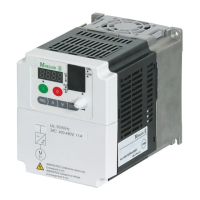09/01 AWB8230-1412GB
PID controller
89
Setpoint definition
There are three ways of entering the setpoints:
• Keypad
• Digital control signal terminal input (4 bit)
• Analog input (terminals O-L or OI-L)
If the digital setpoints are defined through the control signal termi-
nals, define the required setpoint value in PNU A21 to A35. The
setting procedure is similar to the one which is used in frequency
regulation mode (i.e. with a deactivated PID controller) for setting
the respective fixed frequencies (a Section ”Fixed frequency FF1
to FF4 selection”, Page 56).
Actual value feedback and actual value signal matching
You can specify the actual value signal as follows:
• With an analog voltage on control signal terminal O
(maximum 10 V)
• With an analog current on control signal terminal OI
(maximum 20 mA)
One of the two methods mentioned is selected via PNU A76.
To adapt the operation of the PID controller to the respective appli-
cation, the actual value feedback signal can also be matched as
shown in Figure 89:
As evident from the graphs, the setpoint value must be within the
valid range on the vertical axis if you have set functions PNU A11
and A12 to a value not equal to 0. Because there is no feedback
signal, stable control cannot otherwise be guaranteed. This means
that the frequency inverter will either
• output the maximum frequency,
• go to stop mode,
• or output a lower limit frequency.
PNU A13 = 20 %
PNU A14 = 100 %
PNU A13 = 0 %
PNU A14 = 50 %
PNU A13 = 25 %
PNU A14 = 75 %
PNU A13 = 20 %
PNU A14 = 100 %
PNU A11 = 25 %
PNU A12 = 100 %
PNU A13 = 0 %
PNU A14 = 50 %
PNU A11 = 0 %
PNU A12 = 75 %
PNU A13 = 25 %
PNU A14 = 75 %
PNU A11 = 25 %
PNU A12 = 75 %
Figure 89: Analog actual value signal matching
100
0
10 V2 V
20 mA4 mA
100 %20 %
[%]
f
100
0
10 V5 V
20 mA10 mA
100 %50 %
[%]
f
100
0
10 V2.5 V
20 mA5 mA
100 %25 %
7.5 V
15 mA
75 %
[%]
f
100
0
10 V2 V
20 mA4 mA
100 %20 %
25
[%]
f
100
0
10 V5 V
20 mA10 mA
100 %50 %
75
[%]
f
100
0
10 V2.5 V
20 mA5 mA
100 %25 %
7.5 V
15 mA
75 %
25
75
[%]
f

